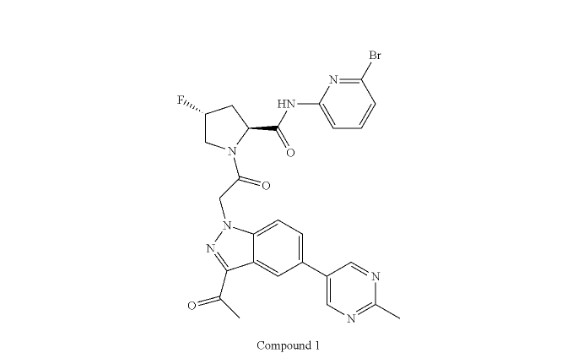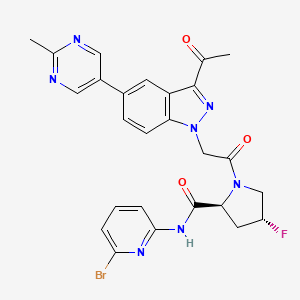
Danicopan
USFDA 3/29/2024, To treat extravascular hemolysis with paroxysmal nocturnal hemoglobinuria, Voydeya
C26H23BrFN7O3
580.418
(2S,4R)-1-[2-[3-acetyl-5-(2-methylpyrimidin-5-yl)indazol-1-yl]acetyl]-N-(6-bromopyridin-2-yl)-4-fluoropyrrolidine-2-carboxamide
- ACH 0144471
- ACH-4471
- ACH0144471
- ALXN 2040
- ALXN-2040
- ALXN2040
Danicopan, sold under the brand name Voydeya, is a medication used for the treatment of paroxysmal nocturnal hemoglobinuria.[2] It is a complement inhibitor which reversibly binds to factor D to prevent alternative pathway-mediated hemolysis and deposition of complement C3 proteins on red blood cells.[2]
Danicopan was approved for medical use in Japan in January 2024, and in the United States in March 2024.[3][4]
Paroxysmal nocturnal hemoglobinuria (PNH) is a rare acquired hematologic disease characterized by hemolysis, thrombophilia, and bone marrow dysfunction.1,7 Both hemolysis and thrombophilia are mediated primarily by the complement system.1 Standard therapy for PNH involves the use of complement C5 inhibitors (e.g. eculizumab, ravulizumab) which are effective in mitigating complement-mediated intravascular hemolysis and thromboembolism.1 Unfortunately, complement C5 inhibition does not address C3-mediated extravascular hemolysis, which occurs earlier in the complement cascade within the alternative pathway.1,5
Danicopan is a small molecule complement factor D inhibitor that selectively blocks the alternative pathway, thereby working to address extravascular hemolysis when used in conjunction with C5 inhibitors.3 It was first approved in January 2024 in Japan for patients with PNH,2,6 shortly after which the EMA adopted a positive opinion and recommended granting it marketing authorization.2 It was subsequently approved by the FDA in March 2024.4
SYN
WO2015130795
SYN
https://patents.google.com/patent/US9796741

SYN
https://patentscope.wipo.int/search/en/detail.jsf?docId=WO2023158772&_cid=P10-LUV2QK-25994-2
PAT
https://patents.google.com/patent/US20230094124A1/en
https://patents.google.com/patent/US20230094124A1/en



-
Step 1: Synthesis of tert-Butyl (2S,4R)-2-((6-bromopyridin-2-yl)carbamoyl) fluoropyrrolidine-1-carboxylate (3): N-Boc-trans-4-Fluoro-L-proline (50.8 kg) was added to DCM (1000 L) in a glass-lined reactor under an atmosphere of nitrogen. The reaction mixture was cooled to 0±5° C. and N-methylimidazole (44.7 kg) was added while maintaining the temperature at 0±5° C. Methanesulfonyl chloride (29.97 kg) was slowly added to the reaction mixture followed by the addition of 2-amino-6-bromopyridine (2). The reaction temperature was warmed to room temperature and stirred for 12 h. The reaction was monitored by HPLC. After completion of the reaction water (2,000 kg) was added, the reaction was stirred and the DCM layer separated. The aqueous layer was once more extracted with DCM (1000 L). The combined DCM layer was washed in succession with dilute HCl, aqueous NaHCO3 and brine. The DCM extract was evaporated to dryness and tert-butyl (2S,4R)-2-((6-bromopyridin-2-yl)carbamoyl)-4-fluoropyrrolidine-1-carboxylate (3) was isolated using DCM heptane mixture and dried. Yield, 71.76 Kg (84.86%))
- [0404]
Step 2: Synthesis of (2S,4R)-N-(6-Bromopyridin-2-yl)-4-fluoropyrrolidine-2-carboxamide (4): To a solution 4M HCl/Dioxane (168 kg) was added intermediate 3 (40 kg) at 25±5° C. under an atmosphere of nitrogen and the reaction was stirred for 1 h. The reaction was monitored by HPLC and after completion, the reaction was diluted with DCM (800 L) and washed with aqueous NaHCO3. The DCM layer was separated and concentrated. The product, 2S,4R)-N-(6-bromopyridin-2-yl)-4-fluoropyrrolidine-2-carboxamide, (4), was isolated using DCM/heptane and dried. Yield, 25.81 kg, 87%.
- [0405]
Step 3: Synthesis of tert-Butyl 2-(3-acetyl-5-bromo-1H-indazol-1-yl)acetate (6): 1-(5-Bromo-1H-indazol-yl)ethan-1-one (5, 30 kg) was added to a reactor containing DMF (210 L) under an atmosphere of nitrogen followed by potassium carbonate (4.05 kg). Tert-butyl bromoacetate (3.42 kg) was added to the reaction mixture with stirring and maintaining the temperature at 30±10° C. After addition was complete, the reaction mixture was heated at 50±5° C. for 1 h. After the reaction was complete the reaction mixture was cooled to 25±5° C. and diluted with water (630 L). The precipitated solid was filtered, washed with water (90 L) and dried. Yield, 43.13 kg, 97.13%.
- [0406]
Step 4: Synthesis of tert-Butyl 2-(3-acetyl-5-(2-methylpyrimidin-5-yl)-1H-indazol-1-yl)acetate (9): Bispinnacolato diboron (14.67 kg) was added to a solution of 4-bromo methylpyrimidine (7, 10 kg) in dioxane (206 kg) under an atmosphere of nitrogen followed by the addition of potassium acetate (17 kg). The reaction mixture was degassed using nitrogen. Pd(dppf)Cl2 (0.94 kg) was added and the reaction mixture heated to 90±5° C. until the pyrimidine was consumed. The reaction mixture was cooled to 25±5° C. and intermediate 6 (16.33 kg) was added followed by potassium carbonate (20.7 kg) and water (16.33 kg) and the reaction was degassed using nitrogen. The reaction was again heated to 90±5° C. until completion. The reaction mixture was cooled to 25±5° C. and diluted with ethyl acetate (269 kg) and water (150 kg) maintaining the temp at 10±5° C. Activated charcoal (1 kg) was added to the mixture with stirring and then filtered through a bed of celite. The ethyl acetate layer was separated, washed with 5% aqueous sodium chloride followed by 5% L-Cysteine solution to remove palladium related impurities. The ethyl acetate layer was evaporated to dryness. The product (9) was isolated from MTBE/heptane. Yield, 11.8 kg, 56%.
- [0407]
Step 5: Synthesis of 2-(3-Acetyl-5-(2-methylpyrimidin-5-yl)-1H-indazol-1-yl)acetic acid (10): To a stirred solution of intermediate 9 (50 kg) in DCM (465 kg) at 15±5° C. was added TFA (374.5 kg) while maintaining the said temperature. The reaction was warmed to 35±5° C. and stirring continued until completion of the reaction. DCM and TFA were distilled off under reduced pressure. The residue was dissolved in DCM (kg) and stirred with aqueous sodium bicarbonate. The biphasic mixture was acidified with concentrated HCl and the pH was adjusted to 2-3. The precipitated solid was filtered, washed with water and dried. Yield, 42.4 kg, quantitative.
- [0408]
Step 6: Synthesis of Compound 1: To a solution of intermediate 9 (42 kg) in DMF (277 kg) was added intermediate 4 (38.7 kg) and the reaction was cooled to 10±5° C. Coupling agent TBTU (56.7 kg) was added to the reaction mixture followed by the addition of DIPEA (86.5 kg) while maintaining the reaction temperature at 10±5° C. The reaction was warmed to 25±+5° C. and stirred until complete. The reaction mixture was diluted with ethyl acetate (1344 kg) and washed with water twice. (The reaction may be washed with aq. K2CO3 if fluorine related impurities are present.) Anhydrous sodium sulfate was added to silica gel and added to the ethyl acetate layer and filtered. The ethyl acetate layer was passed over a column of silica gel (40 kg) and the pure fractions were collected. The fractions were treated with activated charcoal and then filtered over celite. The palladium content was checked, and if above 10 ppm, the ethyl acetate layer was treated with palladium scavenging resin (SilabondThiol®). The ethyl acetate was evaporated to dryness under vacuum and the residue was crystallized from IPA (crystalline seed may be added) and heptane to afford Compound 1 Form II. Yield, 60 kg, 78%.
Society and culture
Legal status
In February 2024, the Committee for Medicinal Products for Human Use of the EMA adopted a positive opinion, recommending the granting of a marketing authorization for the medicinal product Voydeya, intended as add-on therapy to ravulizumab or eculizumab for the treatment of residual hemolytic anemia in adults with paroxysmal nocturnal hemoglobinuria (PNH).[2][5] The applicant for this medicinal product is Alexion Europe.[2]
Names
Danicopan is the international nonproprietary name.[6]
 |
|
| Clinical data | |
|---|---|
| Trade names | Voydeya |
| Other names | ACH-4471 |
| Routes of administration |
By mouth |
| Drug class | Complement factor D inhibitor |
| ATC code | |
| Legal status | |
| Legal status | |
| Identifiers | |
| CAS Number | |
| DrugBank | |
| ChemSpider | |
| UNII | |
| KEGG | |
| ChEMBL | |
| ECHA InfoCard | 100.398.865 |
| Chemical and physical data | |
| Formula | C6H3BrFN7O3 |
| Molar mass | 320.038 g·mol−1 |
| 3D model (JSmol) | |
|
|
|
|
References
- ^ “Novel Drug Approvals for 2024”. U.S. Food and Drug Administration. 1 April 2024. Retrieved 2 April 2024.
- ^ Jump up to:a b c d “Voydeya EPAR”. European Medicines Agency. 22 February 2024. Archived from the original on 23 February 2024. Retrieved 24 February 2024. Text was copied from this source which is copyright European Medicines Agency. Reproduction is authorized provided the source is acknowledged.
- ^ “Voydeya (danicopan) granted first-ever regulatory approval in Japan for adults with PNH to be used in combination with C5 inhibitor therapy”. AstraZeneca (Press release). 19 January 2024. Archived from the original on 24 February 2024. Retrieved 24 February 2024.
- ^ Research Cf (4 April 2024). “Novel Drug Approvals for 2024”. FDA.
- ^ “First oral treatment against residual hemolytic anemia in patients with paroxysmal nocturnal hemoglobinuria”. European Medicines Agency (EMA) (Press release). 23 February 2024. Retrieved 24 February 2024.
- ^ World Health Organization (2019). “International nonproprietary names for pharmaceutical substances (INN): recommended INN: list 81”. WHO Drug Information. 33 (1). hdl:10665/330896.
Further reading
- Lee JW, Griffin M, Kim JS, Lee Lee LW, Piatek C, Nishimura JI, et al. (December 2023). “Addition of danicopan to ravulizumab or eculizumab in patients with paroxysmal nocturnal haemoglobinuria and clinically significant extravascular haemolysis (ALPHA): a double-blind, randomised, phase 3 trial”. The Lancet. Haematology. 10 (12): e955–e965. doi:10.1016/S2352-3026(23)00315-0. PMID 38030318.
External links
- “Danicopan (Code C148181)”. NCI Thesaurus.
//////////fda 2024, Voydeya, danicopan, approvals 2024, ACH-4471, ACH 4471, ACH 0144471, ACH-4471, ACH0144471, ALXN 2040, ALXN-2040, ALXN2040















